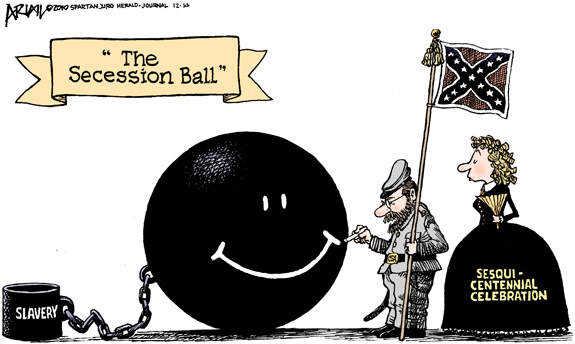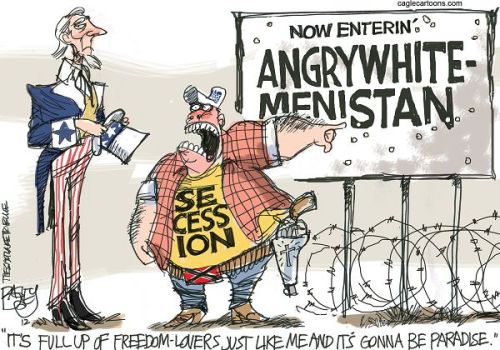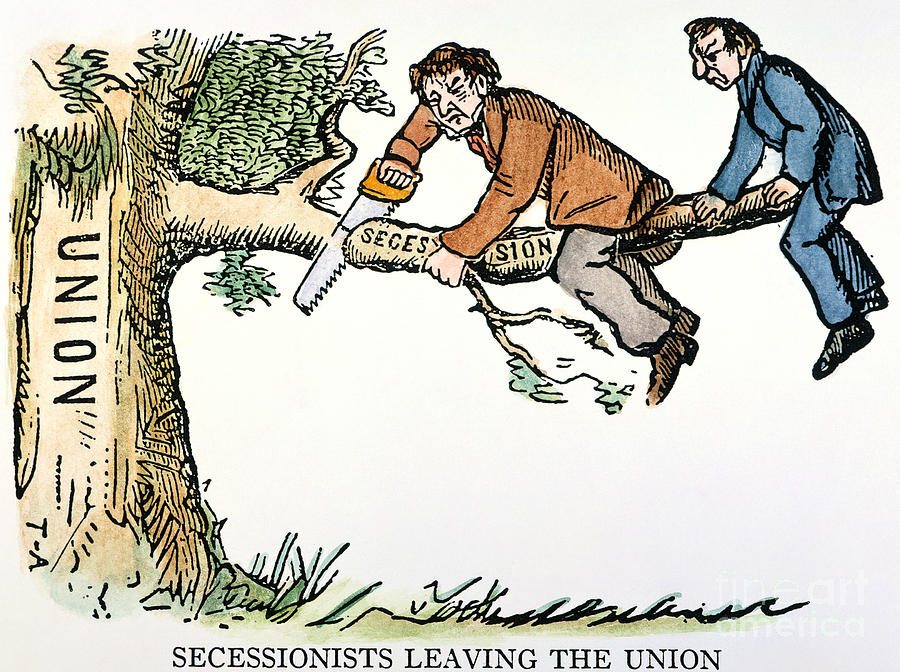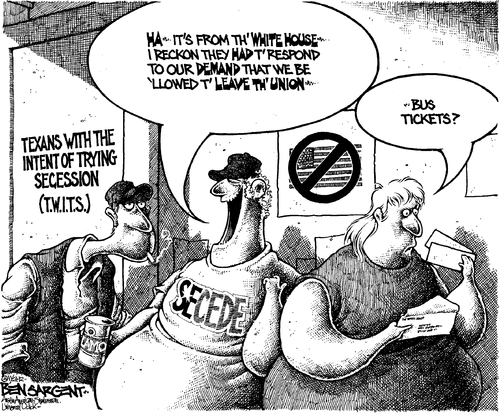
From the Washington Post, "At Charleston's Secession Ball, divided opinions on the spirit of S.C.," by Manuel Roig-Franzia, 22 December 2010 -- CHARLESTON, S.C.- "Dixie," that emotionally freighted and much-debated anthem of the old Confederacy, starts soft when it's done right, barely above a whisper. But each sotto voce syllable of the opening verse, each feather-light scrape of the fiddle strings, could be heard without straining when the ladies in the hoop skirts and the men in the frock coats rose in reverence to celebrate the 150th anniversary of South Carolina's secession.
"We are very proud of who we are," said Chip Limehouse, a South Carolina legislator who rented a historically accurate suit and vest for the formal ball celebrating the anniversary. "This is in our DNA."
Great-great-great-granddad fought the Yankees, lost his plantation, was bathed in glory, the men and women at the ball like to say. They're proud of their ancestors, they declare, and that's why they paid $100 apiece to take part in an event touted as a "joyous night of music, dancing, food and drink."

Stegelin's Cartoon: Secession Ball fashion tips
Outside Charleston's bulky concrete municipal auditorium, on an unseasonably chilly Southern night, some of the men and women in a crowd of about 100 were thinking about their own ancestors: slaves who picked the cotton for the forebears and allies of the men and women inside. "Disgusting," the Rev. Joseph A. Darby, vice president of the local NAACP chapter, said of the event inside.
On the street, they lifted protest signs; inside, they lifted drinks with names like "Rebel Yell." The stubborn inside-outside faceoff that throttled this jewel of a Southern city on Monday night hints at dramas to come, an unending series of Civil War anniversaries stretching from secession and the firing on Fort Sumter to the laying down of arms at Appomattox. For the next 41/2 years - the span of the bloodiest conflict in U.S. history - Americans black and white will have ample opportunities to wrestle with delicate, almost-impossible-to-resolve questions of legacy and history, of what to commemorate and what to condemn.

South Carolina was the first state to secede from the Union, but the commemoration will be followed by similar events in other states - parades and balls and speeches and plaques. The anniversaries will press current politicians to tiptoe through minefields of nuance. Charleston Mayor Joe Riley called the Secession Ball "unfortunate" and "the opposite of unifying," but several big-name lawmakers not only attended, but donned costumes to do so.
The emotions of the day were on display at a ceremony dedicating a historical marker about the secession. Someone in the audience yelled "You're a liar" when Riley told the crowd that South Carolinians were motivated to secede, in part, by a desire to preserve slavery. Riley has invited President Obama to narrate portions of Abraham Lincoln's greatest speeches in an observance of the firing on Fort Sumter; it's unclear whether he will accept.

When Lincoln's name was mentioned at the Secession Ball's theatrical performance, a reenactment of South Carolina's secession convention that drew from historical documents, the actors hissed. "Impeach," one of the actors called out. Lincoln and the North were responsible for "vulgar tyranny," the actors said. A narrator intoned that the 169 South Carolina men who voted unanimously to secede were "compelled by the same sublime courage" as the men who fought against Britain in the Revolutionary War the century before. Slavery was mentioned, but the main reasons for secession were portrayed as high tariffs and Northern states using Southern tax money to build their own infrastructure.
The star of the show, playing the convention president, is one of South Carolina's most powerful present-day politicians, state Senate President Pro Tempore Glenn McConnell, a Confederate heritage defender who has owned a Civil War memorabilia business. McConnell gets a kick out of reenacting battles and is known for firing his personal cannon, dubbed "Big Ray."

The guests, enthusiasts in tuxedos, flouncy skirts or militia uniforms, sashayed from the cavernous theater into a party room where images of huge Confederate battle flags were projected on the wall. Two African American police officers leaned glumly against a wall in the hallway as the predominantly white crowd filed past. Guests picked at ham and biscuits while a string band with a defiant name - Un-Reconstructed - played waltzes and the Virginia reel. A receiving line formed; women curtsied and men dramatically doffed their top hats. At times, it seemed like a dress-up party for grown-ups.
Many in the crowd are members of "secession camps," small groups of Civil War history buffs collected under the banner of the Sons of Confederate Veterans. And there were the battle reenactors - men whom Civil War tour guide Jack Thomson, a guest at the ball, calls "the bang-bang, shoot-'em-up types." Their intricate uniforms, with brass buttons and braid-draped epaulets, can cost upward of $1,000 each. On any given weekend in the South, someone slips into gray or blue to relive bygone battles, plotting counterattacks and flanking maneuvers. Limehouse's family once offered their plantation - Airy Hall - for a battle reenactment. "They were out there getting eaten up by no-see-ums," his wife, Sue, said of the true believers. "Torture. Pure torture."
Chip, a parking company owner who represents Berkeley and Charleston counties in the South Carolina House of Representatives, grinned when the subject of the protests came up. "They actually helped ticket sales," Limehouse said of the protestors. "We'd like to thank them. Without them, we wouldn't have made budget."
John B. Hines, a wealthy Texas oilman and cattle rancher, helped, too. He sent a $5,000 sponsorship for the affair because he loves the Old South: "They created a society far and above anything else on Earth." As for the NAACP demonstrators outside, Hines said, their arguments are "nonsense. The NAACP's just hard up for a reason to bitch at people."
The central argument both inside and outside the auditorium is the same one that enlivened the Charleston mayor's news conference earlier in the day: the role of slavery in the decision to secede. A favorite citation of the crowd at the ball comes from Charles Dickens. "He said, 'The Northern onslaught upon slavery was no more than a piece of specious humbug designed to conceal its desire for economic control of the Southern states,' " said John Zebelean, a retired U.S. Air Force lieutenant colonel from Baltimore who attended the ball. "It's all there! You can look it up."
Darby, the NAACP vice president, spent much of the day talking about documents drafted during the secession commission that mention slavery repeatedly and cite it as a prime motivating factor. But the point, he said, is not merely a matter of historical contention. Celebrating secession, he says, contributes to an atmosphere of inequality in present-day South Carolina, where fights over the quality of education and job opportunities for African Americans still simmer. Reminders of secession are everywhere. In Charleston, there's a Secessionville Road; in Beaufort, there's a Secession Golf Club.
Darby said that the day before the ball, he ran into a white man whose ancestor was one of the signers of the secession ordinance; the man was "distressed" about the ball and had no plans to attend. They got to talking about their bloodlines, and the man mentioned the name of the signer: Artemus Darby. In those days it was common for slaves to take the names of their masters. "I looked at him and said, 'Hello, cousin,' " Darby said.

Another ancestor of a secession ordinance signer was among the guests inside the Secession Ball. As he was leaving, David J. Rutledge - whose great-great-great-grandfather was the secession convention president played by McConnell - turned to a woman in a fur shawl and said: "You're going to be mad at me. . . . I believe it was about slavery."
Thomson, the tour guide, chimed in, parsing the debate. "Forgive me, I would say it's more about antislavery," he said. "People in the North who didn't own slaves getting involved."

Rutledge wasn't budging, despite the disapproving glances.
Hoop skirts and frock coats funneled past him toward the exits, disappearing from view as they summited the staircase. When Rutledge's great-great-great-grandfather signed the secession ordinance, there was an overflow crowd of more than 3,000 on hand to watch. When it came time to celebrate the signing's sesquicentennial, about 300 people came. Most of the seats in an auditorium that holds more than 2,700 were empty. (source: The Washington Post)


0 comments:
Post a Comment